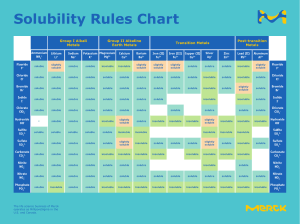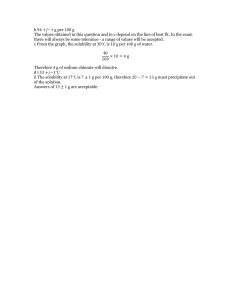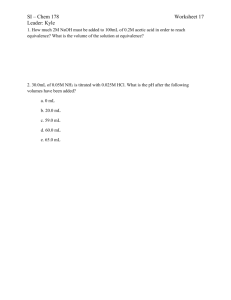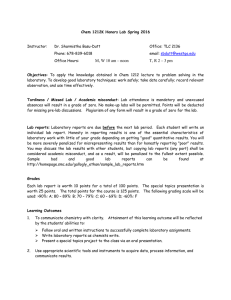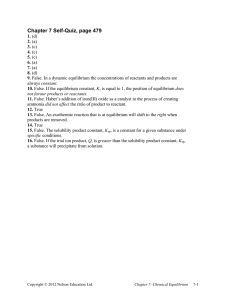CO2 Solubility in Water & Sea Water: -5° to 25°C, 10-45 Atm
advertisement
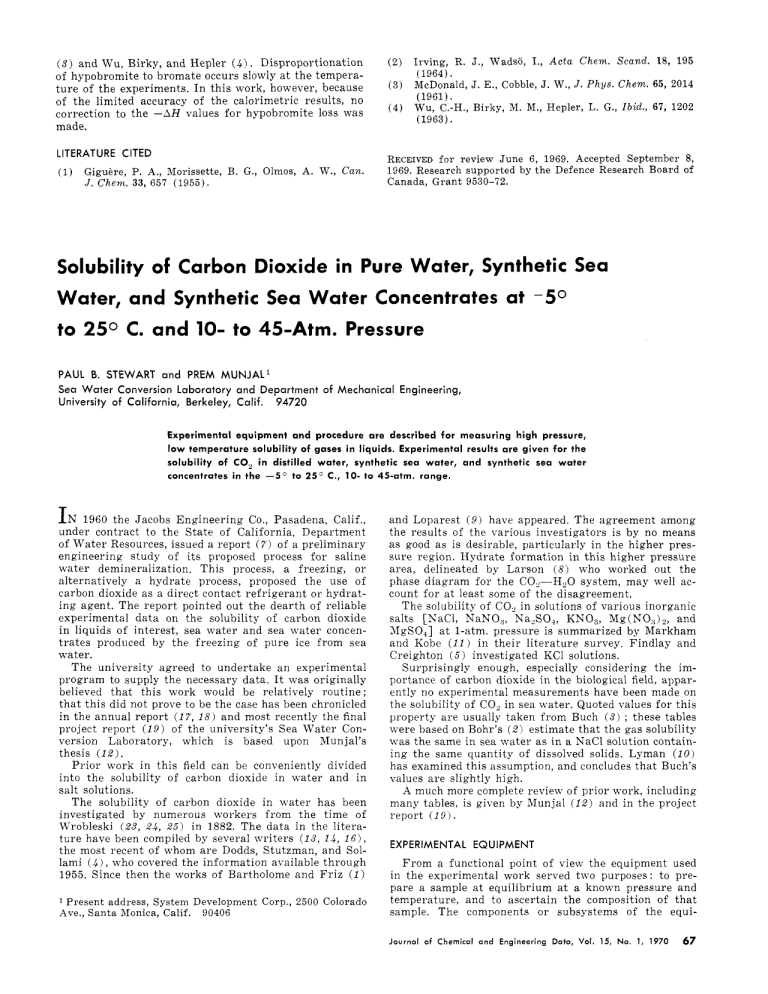
(3) and Wu, Birky, and Hepler (4). Disproportionation
of hypobromite to brómate occurs slowly at the temperature of the experiments. In this work, however, because
of the limited accuracy of the calorimetric results, no
correction to the —AH values for hypobromite loss was
made.
LITERATURE CITED
(1)
Giguére, P. A., Morissette, B. G., Olmos, A. W., Can.
J. Chem. 33, 657 (1955).
(2)
(3)
(4)
Irving, R. J., Wadso, I., Acta Chem. Scand.
18, 195
(1964).
McDonald, J. E., Cobble, J. W., J. Phys. Chem. 65, 2014
(1961).
Wu, C.-H., Birky, . M„ Hepler, L. G„ Ibid., 67, 1202
(1963).
Received for review June 6, 1969. Accepted September 8,
1969. Research supported by the Defence Research Board of
Canada, Grant 9530-72.
Solubility of Carbon Dioxide in Pure Water, Synthetic Sea
Water, and Synthetic Sea Water Concentrates at -5°
to 25° C. and 10- to 45-Atm. Pressure
PAUL B. STEWART and PREM MUNJAL1
Sea Water Conversion Laboratory and Department of Mechanical Engineering,
University of California, Berkeley, Calif.
94720
Experimental equipment and procedure are described for measuring high pressure,
low temperature solubility of gases in liquids. Experimental results are given for the
solubility of C02 in distilled water, synthetic sea water, and synthetic sea water
concentrates in the —5° to 25° C., 10- to 45-atm. range.
In
I960 the Jacobs Engineering Co., Pasadena, Calif.,
under contract to the State of California, Department
of Water Resources, issued a report (7) of a preliminary
engineering study of its proposed process for saline
water demineralization. This process, a freezing, or
alternatively a hydrate process, proposed the use of
carbon dioxide as a direct contact refrigerant or hydrating agent. The report pointed out the dearth of reliable
experimental data on the solubility of carbon dioxide
in liquids of interest, sea water and sea water concentrates produced by the freezing of pure ice from sea
water.
The university agreed to undertake an experimental
program to supply the necessary data. It was originally
believed that this work would be relatively routine;
that this did not prove to be the case has been chronicled
in the annual report (17, 18) and most recently the final
project report (19) of the university’s Sea Water Conversion Laboratory, which is based upon Munjal’s
thesis (12).
Prior work in this field can be conveniently divided
into the solubility of carbon dioxide in w'ater and in
salt solutions.
The solubility of carbon dioxide in water has been
workers from the time of
investigated by numerous
Wrobleski (23, 2k, 25) in 1882. The data in the literature have been compiled by several writers (13, 1U, 16),
the most recent of whom are Dodds, Stutzman, and Sollami (4), who covered the information available through
1955. Since then the works of Bartholome and Friz (1)
Present address, System Development Corp., 2500 Colorado
Ave., Santa Monica, Calif. 90406
1
and Loparest (9) have appeared. The agreement among
the results of the various investigators is by no means
as good as is desirable, particularly in the higher pressure region. Hydrate formation in this higher pressure
area, delineated by Larson (8) who worked out the
phase diagram for the C02—H20 system, may well account for at least some of the disagreement.
The solubility of CO·, in solutions of various inorganic
salts [NaCl, NaN03, Na,S04, KNOs, Mg(N03)2, and
MgS04] at 1-atm. pressure is summarized by Markham
and Kobe (11) in their literature survey. Findlay and
Creighton (5) investigated KC1 solutions.
Surprisingly enough, especially considering the importance of carbon dioxide in the biological field, apparently no experimental measurements have been made on
the solubility of C02 in sea water. Quoted values for this
property are usually taken from Buch (3) ; these tables
wrere based on Bohr’s (2) estimate that the gas solubility
was the same in sea water as in a NaCl solution containing the same quantity of dissolved solids. Lyman (10)
has examined this assumption, and concludes that Buch’s
values are slightly high.
A much more complete review of prior work, including
many tables, is given by Munjal (12) and in the project
report (19).
EXPERIMENTAL EQUIPMENT
From a functional point of view the equipment used
in the experimental work served two purposes: to prepare a sample at equilibrium at a known pressure and
temperature, and to ascertain the composition of that
sample. The components or subsystems of the equiJournal of Chemical and Engineering Data, Vol. 15, No.
1,
1970
67
librium assembly are: the pressure vessel, or autoclave,
bomb, the agitation mechanism, the constant temperature system, the pressure-control system, and the
sample-withdrawal system. These various units are
briefly described below, and in much more complete
detail by Munjal (12) and in the project report (19).
or
Pressure Vessel. The pressure vessel is made of cast
Monel and is 3 1/2 inches in inside diameter by 7 inches
in inside height, 1/2-inch wall thickness with a hemispherical bottom. The closure flange is cast integrally
with the vessel. The cover plate is a forged Monel blank
welding flange. Design pressure is 1500 p.s.i. This unit
with the assembled piping (Monel tubing) connections
is shown schematically in Figure 1.
Agitation Mechanism. The agitation system used rocks
the pressure vessel through an angle of 29.6 degrees
58.3 cycles per minute. As shown in Figure 2, the system comprises a 1/2-hp. motor, geared speed reducer,
driving wheel, driving arm with cam follower connection to driving wheel, and the autoclave holder on the
oscillating shaft. This design was adapted from one
successfully used in the Berkeley Petroleum Engineering Department for hydrocarbon P-V-T work.
Constant Temperature System. The constant temperature
system or thermostat is made up of three tanks fabricated from sheet copper and thermally insulated with 2
inches of Foamglas. The first tank, the chiller, has
copper coils on the inside through which evaporating
Freon-12 circulates as needed to cool the heat transfer
medium, a methanol-water solution, to a fraction of a
degree below the desired equilibrium temperature. The
chiller tank is stirred with a propeller agitator. The
methanol solution, used in preference to brine to minimize corrosion problems, is pumped at a manually controlled rate to the autoclave tank.
The autoclave tank, and the sampling assembly tank
connected to it by a vertical slot, are both agitated or
stirred by the rocking of the pressure vessel or auto-
MES$U»C CAGES
F»ESSU«{ AECOFOM
Figure 2. Front view of mechanical shaking assembly
clave. An electric immersion heater, thermostatically
controlled, heats the subcooled methanol to the desired
temperature. The methanol solution is returned to the
chiller tank by gravity flow. Temperature control with
this system was ±0.06° C. The temperature was recorded continuously on a Foxboro industrial-type
instrument.
Pressure Measurement and Control. The autoclave was
pressurized by admitting gas from a standard liquefied
CCD cylinder (Matheson Co., research grade, 99.99%
purity), and the pressure was reduced, if required, by
venting gas. All pressure control was manual. Pressure
was
measured with calibrated precision Bourdon-tube
gages of 0 to 100, 0 to 500, and 0 to 1500 p.s.i. range.
With these gages pressures could be read to ±0.25 p.s.i.
below 500 p.s.i. and to ±0.50 p.s.i. in the higher range.
Pressure was monitored with a standard Foxboro industrial instrument.
Sampling Assembly. The containers for the pressurized
equilibrium samples were double-ended Monel tubes
closed on each end with Monel needle valves, all manufactured by Hoke, Inc., Englewood, N. J. The valves
required lapping in for pressure-tight operation. The
sample tube and the connections to the autoclave are
shown in Figure 1.
The sampling assembly is immersed in the auxiliary
sampling tank maintained at the same temperature as
the equilibrium vessel. The original tank for the equilibrium bomb did not provide sufficient room for convenient manipulation during the sampling process,
which necessitated its enlargement by the addition of
the third tank.
The entire assembly of all components of the equilibrium equipment is shown schematically in Figure 3.
Chemical Analysis Equipment. The method for chemical
analysis of the liquid sample was to distill the CCD out
of the sample, absorb it in an excess of standard
Ba(OH),, and back-titrate the excess base. The apparatus and procedure have been described (12, 19, 20).
SYNTHETIC SEA WATER PREPARATION
Figure
68
Since natural sea water is variable in composition,
all sea water used in these experiments was prepared
synthetically. The recipe used for this synthetic sea
water was that developed by Brujewicz as reported in
1. Assembly of oscillating autoclave
with sample tube and controls
Journal of Chemical and Engineering Data, Vol. 15, No.
1,
1970
Table
I.
Table II. Solubility of C02 in Distilled H20
Synthetic Sea Water Composition (21)
G. C02 per 100 G. H20
Concentration
Component
NaCl
MgCh
MgSOr
CaCh
KC1
NaHCOs
NaBr
Total Salts
H20
G./kg.
26.518
2.447
3.305
1.141
0.725
0.202
0.083
34.420
965.579
G./l.
27.133
2.504
3.382
1.167
0.742
0.207
0.085
35.220
964.78
Subow’s “Oceanographical Tables” (21). Relatively
concentrated solutions of the various salts used (all
reagent grade chemicals) were first made up in deaerated distilled water, and then standardized by chemical analysis to determine the exact salt content. The
synthetic sea water was then made up from these stock
solutions by volumetric measurement. For synthetic sea
water of normal salt concentration the composition is
given in Table I; the more concentrated solutions, threefold and fivefold concentrates, are what the name
indicates.
The C02 in the 0.202 gram of NaHCO:l per kg. of
synthetic sea water is included in the values for grams
of C02 per 100 grams of solvent reported in this work;
the effect of doing this is to add not more than 1 part
in the second decimal place.
Pressure,
0° C.
5° C.
10° C.
10
20
25
30
38
45
3.133
2.603
4.492
2.102
3.801
6.342
5.455
12.4° C.
25° C.
Atm.
2.403
5.988
6.614
5.503
4.110
approximately 0.06° C. below the desired set point, with
the transfer pump operating. Finally the heater control
is adjusted to the desired temperature. Because of the
large thermal capacity of the system, and consequent
slow response, this procedure required a day or more.
While the temperature of the system was being set,
sample tubes were prepared. This involved lapping in
the valves, filling with C02 to approximately 100 p.s.i.,
weighing, and then checking the weight the following
day. If tight, the tubes were then evacuated to an absolute pressure of 10 microns or less.
Before charging with liquid, the pressure vessel
(autoclave) was pumped down to 10 microns, pressurized with C02 to 100 p.s.i., pumped down again, and
pressurized and pumped down to 10 microns again. The
synthetic sea water storage bottle was then slightly
pressurized with C02, to 2 to 3 p.s.i., and approximately
800 ml. of the liquid admitted to the autoclave. The
pressure in the vessel was then built up to the desired
value by admitting C02.
EXPERIMENTAL PROCEDURE
Temperature setting in the autoclave bath is the first
operation, accomplished by adjusting the refrigeration
thermostat so that the heat transfer liquid is maintained
Agitation (oscillation) of the autoclave was then
started. As the gas goes into solution it is necessary to
of it, from time to time, to maintain the
add more
desired pressure. Equilibrium attainment required from
Figure 3. Flow diagram of equilibrium assembly
Journal of Chemical and Engineering Data, Vol. 15, No. 1, 1970
69
Table III. Solubility of Carbon Dioxide in Synthetic Sea Water
G. CO2/IOO G. Solvent
_
Pressure,
Atm.
1
5
10
15
20
30
34
38
45
-
-5° C.
0.310
1.446
2.752
4.781
6.412
0° C.
0.265
1.248
2.358
3.312
4.152
5.604
6.007
12.4° C.
15° C.
25° C.
0.220
1.043
2.004
0.191
0.889
1.701
0.173
0.790
1.558
0.155
0.740
1.411
0.110
0.551
1.023
3.548
4.843
3.042
4.140
2.805
3.805
2.531
3.453
1.822
2.397
5.601
4.801
4.852
4.379
3.090
5° C.
o
O
Table IV. Solubility of Carbon Dioxide in Synthetic
Sea Water Concentrate
G. CCL/100 G. Solvent
Pressure,
Atm.
0° C.
10
2.149
3.892
5.451
12.4° C.
25° C.
3X Salts Content
20
34
45
1.351
2.411
0.907
1.612
4.052
2.751
5X Salts Content
10
20
34
45
2.043
3.552
5.253
1.214
2.192
3.672
Figure 4. Solubility isobars for CO2 in distilled water
to 14 hours. A first check on the achievement of equilibrium is the pressure remaining constant for some
hours.
To make sure that equilibrium had been attained in
the early experiments samples were taken at varying
times after the constant pressure state had been
reached. No detectable changes were found after the
pressure remained constant for 4 hours, which became
the working criterion for the attainment of equilibrium.
Consistency of the data, and agreement (where possible)
with published values, are further verification of
Data from (J, 2, 6, 15, 22-25)
8
equilibrium.
In the early stages of the work the possibility of
hysteresis effects was checked out by deliberate overpressuring followed by venting to the desired value.
The results obtained by the two methods were identical.
When equilibrium had been achieved, sampling of
the liquid was undertaken. Oscillation of the vessel was
stopped, and it was positioned vertically. Valves 4, 5,
and 7 (Figure 3), previously closed, were then opened,
causing the system pressure to drop slightly. The system
was
then repressurized and agitated again for ca. 30
minutes. Valve 8 was then opened. Again pressure
dropped, followed by repressuring and agitation. Valves
then closed and the sample tube was
4, 5, and 7 were
disconnected at C 1 and C 2. The sample tube was then
dried and weighed, and was ready for chemical analysis.
Check samples were obtained in the same manner.
RESULTS
Solubility of Carbon Dioxide in Pure Water. To verify the
consistency of results obtained with the equipment and
procedures used with those of prior workers, where
70
Journal of Chemical and Engineering Data, Vol. 15, No. 1, 1970
agreement does exist, and to resolve differences also
reported, the first series of experiment were made with
pure water the solvent (Table II).
Figure 4 is a plot not only of the data obtained in
this work but also those of earlier investigators. It
shows that, neglecting a few of the published values,
consistent experimental data now exist for the solubility of CCL in pure water in the 0° to 30° C. temperature range and from 1- to 45-atm. pressure, and that
the methods used in this work give results consistent
with other work.
Also, Figure 4 points up the uncertainty that exists
at 50-atm. pressure. Larson’s work (S) gives a clue to
this: the presence of a hydrate solid phase which would
invalidate an all-liquid sample. Since the equipment used
was not designed for handling solid phase samples, this
pressure was not investigated in this work.
Solubility of Carbon Dioxide in Sea Water and Sea Water
Concentrates. The data obtained for the solubility of CCL
in synthetic sea water, and in synthetic sea water with
3 and 5 times the normal salts concentration, are given
in Tables III and IV.
LITERATURE CITED
(1)
(2)
(3)
(4)
(5)
(6)
Bartholome, E., Friz, Hans, Chem. Ing. Tech. 11, 706
(1956).
Bohr, C., Ann. Physik. 68, No. 3, 500 (1899).
Buch, Kurt, Kemistmotet (Finland), 1928, 184.
Dodds, W. S., Stutzman, L. F., Sollami, B. J., Ind.
Eng. Chem. Data Ser. 1, 92 (1956).
Findlay, A., Creighton, H. J. M., J. Am. Chem. Soc.
97, 536 (1910).
Haehnel, O., Centr. Min. Geol. 25, 240 (1920).
(7)
(8)
(9)
(10)
(11)
(12)
(13)
Jacobs Engineering Co., report to State of California,
Department of Water Resources, August 1960.
Larson, J. D., Ph.D. dissertation, University of Illinois, University Microfilms, Ann Arbor, Mich., Pub.
15, 235 (1955).
Loparest, F. J., J. Phys. Chem. 61, 1128 (1957).
Lyman, John, Fleming, R. H., J. Marine Res. 3, 134
(1940).
Markham, A. E., Kobe, K. A., J. Am. Chem. Soc. 63,
449 (1941).
Munjal, P. K., Ph.D. dissertation, University of California (Berkeley), University Microfilms, Ann Arbor,
Mich., Pub. 67-5126, 1966.
National Research Council, “International Critical
Tables,” Vol. Ill, p. 260, McGraw-Hill, New York,
1928.
(14)
(15)
(16)
Quinn, E. L., Jones, C. L., “Carbon Dioxide,” Reinhold, New York, 1936.
Sander, W., Z. Physik. Chem. 78, 513 (1912).
Seidell, A., Linke, W. F., “Solubilities of Inorganic
and Organic Compounds,” 3rd ed., pp. 89-92, Van
Nostrand, New York, 1952.
Stewart, P. B., Munjal, P. K., University of California, Berkeley Sea water Conversion Laboratory Report
65-1, 35 (1965).
(18) Ibid., 66-1, 39 (1966).
(19) Ibid., 69-2 (1969).
(20) Stewart, P. B., Munjal, P. K., Quiring, F., Anal.
Chem. 41, 1710 (1969).
(21) Subow, N. N., “Oceanographical Tables,” p. 208,
Oceanogr. Inst., Hydro-meteoral Com., Moscow,
U.S.S.R., 1931.
(22) Wiebe, R., Chem. Rev. 29, 475 (1941).
(23) Wroblewski, M. S., Ann. Phys. Chem. 17, 103 (1882).
(24) Ibid., 18, 290 (1883).
(25) Wroblewski, M. S., Compt. Rend. 94, 1355 (1882).
(26) Zel’venskii, Y. D., J. Chem. Ind. (USSR), 14, 1250
(1937).
(17)
Received for review June 13, 1969. Accepted September 9,
1969. Work supported by state funds allocated to it by the
University Water Resources Center.
Refrigerant Mixture of
Monofluoromonochloromethane and Tetrafluorodichloroethane
Physical Properties of
a
JOSEPH V. SINKA
Specialty Chemicals Division, Allied Chemical Corp., Morristown, N. J.
07960
The physical properties presented describe the mixture of 55.1 wt. % monofluoro-
monochloromethane and tetrafluorodichloroethane, forming a minimum-boiling
azeotrope at 291.2° K. The pressure-volume-temperature properties have been
measured and correlated with the Martin-Hou equation of state. The vapor pressure
and liquid densities were fitted to equations and the critical properties obtained.
The
MATERIALS, monofluoromonochloromethane
(Refrigerant 31) and tetrafluorodichloroethane (Refrig-
obtained from commercial sources and
distillation. The purity of each
component, as determined by gas chromatography, was
99.9 mole % or better. The precautions in handling the
mixture were described in a previous publication (4).
As previously (4), the term vapor pressure will be
used to describe the pressure exerted by a vapor when a
state of equilibrium has been reached between a liquid
and its vapor. Obviously, this term is used in the general sense here, since the composition of the vapor and
liquid are not exactly the same, except at the azeotropic
state. However, every effort that was practical was taken
to minimize the vapor space above the mixture and to
obtain data at the bubble point.
The apparatus and techniques employed were discussed
in detail in earlier papers (1, 3, 4). However, a few brief
remarks are made.
The pressure-volume measurements were obtained on
a constant-volume cell constructed of a 300-cc. high-pressure stainless steel cylinder. The sample was confined in
the cell with a 5-cm. stainless steel diaphragm. The volume change due to the displacement of the diaphragm
from the null point was negligible. Nitrogen was used as
the pressure transfer media and the pressure was read
erant 114),
were
purified by fractional
calibrated Heise gages, connected to the system,
covering various ranges.
The critical temperature was determined by observation of the meniscus in a sealed glass tube, which was
slowly heated and cooled in a stirred liquid bath. The
average value of several observations was 415.2° ± 0.1° K.
Extrapolation of the near-critical isochor to the critical temperature determined the critical pressure. This
1 p.s.i.a.
gave a value of 749
The critical density was determined by a standard
rectilinear diameter plot, using the liquid densities calculated from the liquid density equation and saturated
vapor densities calculated from the equation of state.
The value determined was 0.539 ± 0.001 gram per cc.
The temperature was measured with a platinum resistance
thermometer calibrated by the U. S. National
Bureau of Standards (° C. Int., 1948). The volume was
determined by calibration with water and corrected for
thermal expansion, using the coefficient of thermal expansion for stainless steel.
The liquid densities were determined by a float technique. The calibrated glass floats were corrected for
thermal expansion and found accurate to 0.1% over the
range covered. The floats were found incompressible in
the given pressure range by checking their accuracies in
known liquids.
on
-
Journal of Chemical and Engineering Data, Vol. 15, No.
1,
1970
71
